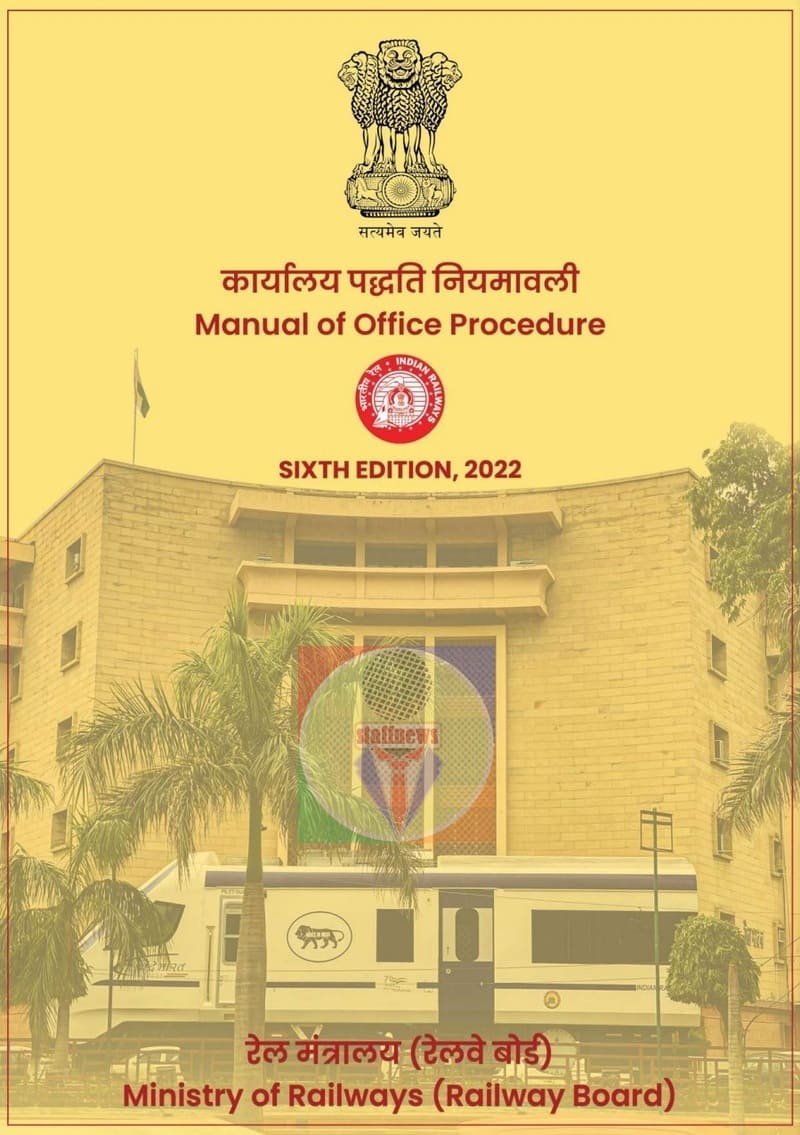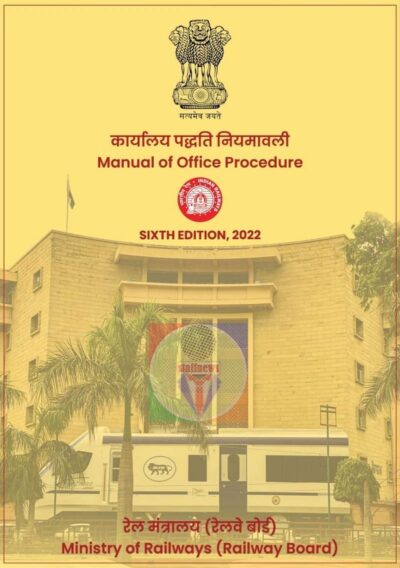Manual of Office Procedure Sixth Edition, 2022 by Ministry of Railway (Railway Board)
Manual of Office Procedure Sixth Edition, 2022
TABLE OF CONTENTS
1. Chapter 1, Definitions
- Definitions of terms used commonly in Official Business
- e-Office Terminology
2. Chapter 2 Machinery of Government
- Government The President
- Council of Ministers
- Allocation/Transaction of Government Business
- Ministry/Department
- Attached and Subordinate Offices
- Constitutional Bodies
- Statutory Bodies
- Autonomous Bodies
- Central Public Sector Enterprises
- Information and Facilitation Counters (IFCs)
3. Chapter Organization of the Ministry of Railways (Railway Board) –
Top, Middle & Secretariat Management:
Brief functions of different functionaries
- Constitutional & legal position of the Ministry of Railways (Railway Board)
- Organisation Structure Of Indian Railways
- Composition of Board & Subjects allotted to Members of the Board
- Directors General
- Directors General
- Secretary, Railway Board
- Board Meeting
- Adviser/Joint Secretaries, Railway Board
- Establishment Officer (EO), Railway Board
- Executive Directors
- Directors/ Joint Directors/Deputy Secretaries
- Deputy Directors/Under Secretaries
- Section Officers
- Assistant Section Officer (ASO), Senior Secretariat Assistant (SSA) or Ex- Cadre
- Staff drafted from Railways – Dealing Officer
- Junior Secretariat Assistant (JSA)
- Multi Tasking Staff (MTS)
- PSOs, Sr.PPS, PPS, PS, PA and Steno Grade ‘D’
- Organization and Methods Unit (O&M)
- Directorates
- Reference of IR Website for detailed duty list of Directorates
4. Chapter 4 Service and Support Units
- Details of Support units and their functions
5. Chapter 5
- Conduct and Discipline
- Service Rules
- Hours of Attendance
- Marking of Attendance
- Casual Leave
- Special Casual Leave
- Compensatory Holiday
- Public Holidays and Restricted Holidays
- Leave on average pay and other recorded leave
- Applications for leave
- Charge Reports/Note for Successor
- Leaving Headquarters
- Addresses of Officers and staff
- Overtime Allowance
- Cleanliness of office surroundings
- Security consciousness
- Care of Government property and consciousness of economy
6. Chapter 6 Staff Grievances Procedure & Welfare Functions
- Permanent Negotiating Machinery
- Joint Consultative Machinery Scheme
- Staff Welfare
7. Chapter 7
- Attached, Subordinate & Field Organisations
- Zonal Railways
- Organization Structure of Zonal Railways
- Production Units
- Other Units
- Centralized Training Institutions
- RRBs
- Other Railway Offices (outside India)
- Public Sector Undertakings under the control of Ministry of Railways
- Autonomous Bodies
- Tribunals
- University/Vishwavidyalaya
8. Chapter 8 Legislative/Parliamentary Business
- Control of the Parliament
- National Railway Users Consultative Council (NRUCC)
- Parliamentary Committees
- Rail Budget
- Questions in the Lok Sabha and the Rajya Sabha
- Types of Parliament Questions
- Handling of Parliament Questions
- Procedure for Dealing with Parliament Questions in the case of dispute
- Government Bills
9. Chapter 9
- Decision making in Government
- Parliamentary form of Government
- Key features of TOB Rules, 1961
- Illustrative list of documents, Nodal Ministry/Directorate in Board’s Office and Website (URL Link)
- Efficiency in Decision Making in the Government
10. Chapter 10 Knowledge Management
- Knowledge Management
- Aids to processing
- Note for Successor (Handing Over Notes)
- Standard Process Sheet
- Standing Guard File
- Standing Note
- Precedent Book
- Reference Folder
- Induction Material
- Master Circulars
- Responsibility Mapping
- Digitization Framework
- Format for Note for the successor
11. Chapter 11 Management of Dak and Receipts
- Receipt of Dak
- Scrutiny of Dak at CR
- Registration of Dak.
- Registration Flow Chart
- Acknowledgement of Dak
- Specimen of Messenger Book
- Distribution of Receipt
- Perusal and Marking/sending of Receipts:
- Movement of receipt
- Action by higher officers
- Allocation of Disputed Receipt/Dak
- Action on Receipt by Directorates/Sections/Units- Dealing Officer, SO and Branch Officer & above
12. Chapter 12 File Management System
- File- Correspondence/Notes portion
- Appendix to Notes/Correspondence portion
- Single File Numbering System- SFS
- Functional File Numbering System- Non SFS
- Instances where files need not be opened
- File register (Case Book)
- Filing of papers- Punching/Tagging/Numbering/Serial Numbers etc.
- Arrangement of papers in a case
- Referencing
- Docketing
- Linking of files
- Part file
- Transfer, Reconstruction and Re-numbering of files
- Movement of files and other papers
- Inter-Sectional References
- Top Secret, Secret and Confidential files
- Urgency grading
13. Chapter 13 Guidelines on Noting
- Note
- Guidelines for noting
- Noting on e-Office- Creation/Recording a Note
- Examination in Section by Dealing Officer
- Examination by Section Officer
- Examination by Branch Officer and above
- Level of disposal and channel of submission- Upward, Downward Movement
- Procedure for submission of cases/files requiring approval of Hon’ble Ministers
- Deviation from normal procedure or rules
- Running Summary of facts
- Oral discussions
- Oral instructions by higher officers
- Oral orders on behalf of or from Minister
- Confirmation of oral instructions
- Modification of notes or order
- Functional Approach to Noting
- Brief Format/Structure of a problem solving/policy and Planning Cases
14. Chapter 14
- Communication- Forms, Channels and Procedure
- Forms of Communication
- Inter-Departmental consultations- ID Note, ID Meeting
- Noting on files received from other Ministries/Departments
- Other forms of written communications
- Letter, Demi Official Letter
- Procedure for Correspondence with Board’s Office by
- ZR/PU
- Office Memorandum
- Office Orders
- Order
- Notification, Resolution
- Press Communique/Press Note
- Endorsement
- Minutes
- Modes of sending communication (Email, fax, speed post, registered post, telephonic communications, etc.)
- Correspondence with Attached and Subordinate offices
- References to Constitutional authorities, etc.
- Rajya Sabha and Lok Sabha Secretariat
- Attorney General of India
- Comptroller and Auditor General of India (C&AG)
- Union Public Service Commission (UPSC)
- Other Constitutional/Statutory Authorities
- Reference to PMO
- Correspondence with Members of Parliament/VIP references/Ministers of State
- Governments
- State Governments
- Union Territory Administration
- Foreign Governments and International Organizations
- Target date for replies
- Use of Official Language in Government communications
- Communication of Sanctions
- Correction slips
- Discontinuation of circulation of hard copies of Orders/Circulars etc.
- Composition of the Gazette of India and instructions for sending material for publication therein
- Procedure to be followed in respect of e-Gazette
15. Chapter 15 Guidelines on Drafting of Communications
- Procedure for preparing draft communication and its approval
- General instructions for drafting
- Authentication of Government Orders
- Addressing communications to officers by name
- Drafting of Demi-official letters
- Responsibility mapping regarding issue of communications
16. Chapter 16
- Records Management
- Activities involved in record management
- Stages of Records Management
- Stage of Recording
- Categorization of Records
- Procedure for Recording
- Indexing & Stage of indexing
- Preparation and custody of index slips
- Record Retention Schedule
- Custody of records
- Custody of Confidential and Secret recorded proceedings
- Review and Weeding of records
- Maintenance/transfer of records in the personal offices of Ministers
- Requisitioning of record
17. Chapter 17 Monitoring of Timely Disposal
- Disposal of work
- Time limits for disposal of cases
- Watch on disposal of communications received from Members of Parliament and VIPs
- Register of Parliament Assurances
- MIS Portal- MORPR for Monitoring MP/MLA/VIP and Parliamentary reference
- Time Limits for Disposal of references addressed to Ministers
- Check-list of periodical reports
- Review of periodical reports/returns
- Updation of data on IR Websites
- Disposal of Pending Matters
18. Chapter 18 Security of Official Information and Documents
- Communication of official information
- Treatment of classified papers
- Confidential character of I.D. notes/files
- Opening of Sealed cover containing classified documents
- Transmission of classified document in electronic form
- Communication of information to the Press
- Brief for Media Coverage
- Use or restrictive classification for printed reports etc.



COMMENTS